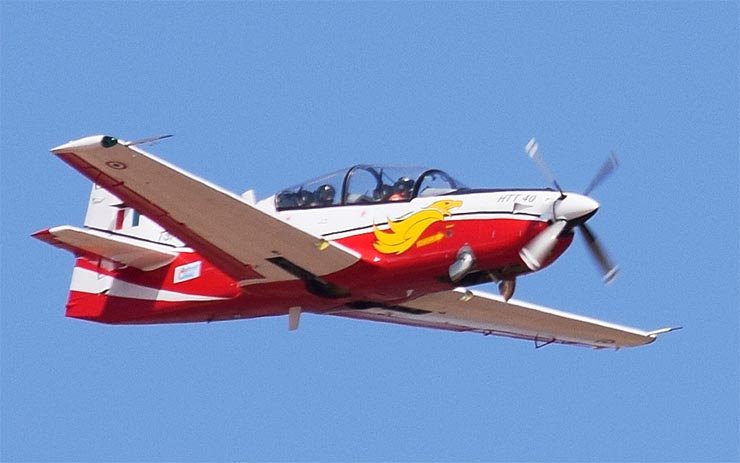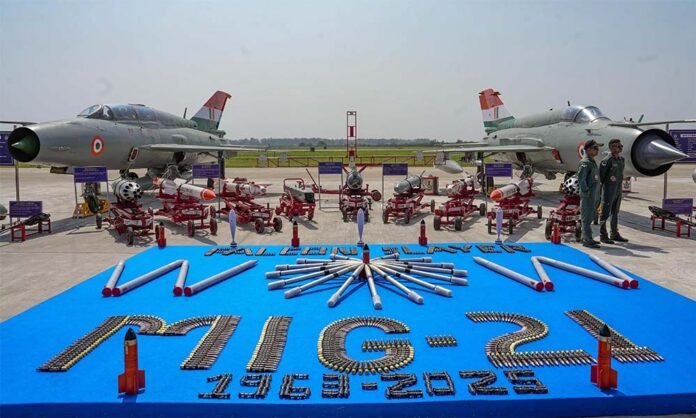On September 26, 2025, the Indian Air Force (IAF) finally bid farewell to its last MiG-21s—the numerically largest fighter fleet in IAF history—after more than six decades of service. The final two squadrons, No. 23 (Panthers) and No. 3 (Cobras), together operating 36 aircraft, stood down in September 2025, formally closing the MiG-21 chapter. With their retirement, the IAF’s active fighter strength slipped to 29 operational squadrons against an authorised 42—the lowest since the 1965 war.
Ageing Airframes That Must Retire Next
Over the next five to ten years, the IAF will have to draw down several legacy fighter types—Jaguar, Mirage-2000I/TI and MiG-29UPG. Six Jaguar squadrons, primarily based at Ambala, Jamnagar and Gorakhpur, are slated for phased retirement around 2030. Three Mirage-2000 squadrons are likely to bow out by 2030 as well. Three MiG-29UPG squadrons are planned for a gradual phase-out beginning approximately 2027–28 and continuing into the early 2040s. Without timely replacements, the number of operational squadrons over the coming decade could dip—well below the level needed for sustained deterrence and two-front contingencies.
Bridging the Post-MiG-21 Gap
To plug the MiG-21-shaped hole, India must accelerate both procurement and production. Indigenous pathways include the Tejas Mk1A already on order, the Tejas Mk2 in advanced development, and the AMCA as the fifth-generation leap. In parallel, 114-aircraft multi-role fighter acquisition from global vendors could bolster numbers and diversify capabilities. Upgrades to existing Su-30MKI fleets can preserve combat relevance until new types arrive. On the air defence side, layered systems such as S-400 and the indigenous Akashteer network can partially offset fighter shortfalls for a time, but they cannot substitute for air dominance fighters in offensive counter-air or deep-strike roles. The IAF’s stated goal is to restore squadron strength to 42 by around 2035; however, unless programs like Tejas Mk1A and Mk2 enter service in meaningful numbers on schedule, the shortfall will continue to erode readiness against regional threats. Fast-tracking both procurement decisions and industrial throughput is therefore essential to rebuild mass and maintain air superiority.
The Hidden Constraint: People, Not Just Planes
Even if new jets landed tomorrow, the IAF would still face an acute shortage of pilots, instructors, mechanics and ground crew to fly, service and sustain them. Airpower is a system—and India’s current bottlenecks are human as much as materiel.
A Persistent Pilot Shortfall
The IAF is currently grappling with a deficit of 600 combat pilots. A typical squadron fields 16–18 aircraft and requires a pilot pool sized for operations, training, leave and attrition. To grow toward the authorised 42 squadrons by the mid-2030s, the IAF needs at least 700–800 additional trained fighter pilots in the pipeline and at units. The Comptroller and Auditor General’s Report No. 15 of 2024, reviewing 2016–2021, documented that the shortfall widened from 486 in February 2015 to roughly 596 by end-2021, largely because annual trainee intake fell below the planned target of 222. The report cautioned that the deficit could persist until at least January 2030. Contributing factors include a competitive civil aviation market and retention pressure once the initial service commitment ends.
In a Right to Information reply reported publicly, the IAF disclosed that 798 pilots resigned over the past decade, with 289 granted No-Objection Certificates to fly with private airlines. Air India’s decision in August 2025 to raise pilot retirement age to 65 only intensifies the pull on experienced military aviators. Alongside attrition risks, delayed modernisation of trainer fleets forces cadets onto ageing platforms, stretching conversion timelines at operational squadrons and slowing the flow of combat-ready wingmen.
Filling flight lines with metal is not enough. Even if new jets landed tomorrow, the IAF would not have enough pilots, instructors, mechanics and ground crew to fly, service and sustain them. Airpower is a system—and India’s current bottlenecks are human as much as materiel
Training Infrastructure: Still Catching Up
Multiple slippages in training assets have compounded the pipeline problem. The induction of 106 Basic Trainer Aircraft (BTA) and 73 Intermediate Jet Trainers (IJT)—both indigenous HAL programs—have faced delays. Existing Pilatus PC-7 Mk-II basic trainers have seen serviceability issues such as engine oil leaks. Helicopter training continues on venerable Chetaks, some over half a century old. Transport pilot training on Dornier-228s suffer from dated avionics relative to contemporary glass-cockpit standards. Simulators and Flying Training Devices are available but many are procedural rather than motion-capable, limiting their ability to replace early-stage air time. Infrastructure delays—weapon ranges, simulator buildings, and supporting facilities—have further constrained realistic training. The CAG concluded that persistent pilot shortages, coupled with training shortfalls, materially threaten operational effectiveness.
Trainer Aircraft and Simulators: The Numbers Problem
The deficit in trainer aircraft directly reduces intake capacity. On December 17, 2024, the Lok Sabha Standing Committee on Defence (18th LS) recorded that the IAF held 238 trainer aircraft against a sanctioned 368—an overall shortfall of 130 across basic, intermediate and advanced stages—while relying on just 14 simulators across types. As of 2025, against a requirement of 181 basic trainers, only about 70–75 Pilatus PC-7 Mk-IIs are in service, leaving a triple-digit gap. The outcome has been an unavoidable squeeze: lower intake, extended course durations and increased dependence on ageing HJT-16 Kirans nearing retirement.
The HTT-40 basic trainer (70 on order) should begin easing basic-stage scarcity from 2025–26 onward, but Stage-II remains the hardest nut to crack. The HJT-36 “Yashas” has progressed technically yet awaits full, sustained induction; a limited lease to bridge the gap is under exploration. Advanced training on roughly 123 Hawk AJTs carries much of the load, but can’t compensate for a missing intermediate fleet. In short: until HTT-40s arrive in strength and a credible IJT solution is fully fielded, the ~130-aircraft trainer deficit will continue to cap throughput.

Instructors: The Human Multiplier
Training a fighter pilot is a ladder—basic flying, advanced jet handling, and finally operational conversion—and every rung depends on experienced Qualified Flying Instructors. India’s constraint is throughput, not talent. Too few QFIs at key schools means fewer sorties per trainee, longer waits between rides and slower progression at each stage. When trainer fleets are thin or high-fidelity simulators are scarce, instructors must spend extra hours in the air covering material that should be taught synthetically on the ground.
Officers and Airmen: Pipeline and Retention, Not Just Hiring
The broader shortage of officers and airmen is driven by retirements, medical attrition and voluntary exits to higher-paying civil aviation, MRO and tech roles—outpacing what training schools can produce. Promotion bottlenecks and frequent postings strain family stability, nudging mid-career talent toward the private sector. The results show up at the unit level: thinner flight-line manning, fewer multi-crew qualifications, slower maintenance turnarounds and higher fatigue—especially in high-skill trades like avionics, engines, electronic warfare and cyber/IT.
Ground Crew: The Next Choke Point
Ground crew will be the immediate constraint. Even before any squadron additions, official submissions to Parliament in 2022 recorded a shortfall of 572 officers and 5,217 airmen—linked by the government to pandemic-era recruitment disruptions. These gaps hurt precisely the trades that keep modern fleets flying: avionics, propulsion, low-observable coatings, radar/EW, weapons and safety armoury. The Standing Committee on Defence has pressed for action to ensure there is no shortage of manpower essential to IAF operations, a reminder that pilots and aircraft alone do not generate combat power; fully staffed technical echelons do. Closing this ground-crew gap through accelerated intake, faster trade training and retention of experienced technicians will determine whether new jets translate into combat-ready squadrons or sit under covers.
Why Modern Jets Demand Deeper Benches
Fifth- and 4.5-generation fighters are maintenance-intensive by design. Rafales and Su-30MKIs fuse advanced sensors, mission computers, software-defined avionics and low-observable treatments—ecosystems that demand specialists: radar and avionics engineers, AI-enabled diagnostics technicians, cyber and mission-data teams capable of rapidly patching, loading and validating software baselines. When these benches are thin, utilisation suffers even with airframes and pilots on hand.
The IAF today is facing a deficit of 600 combat pilots. A typical squadron fields 16–18 aircraft and requires a pilot pool sized for operations, training, leave and attrition. To grow toward the authorised 42 squadrons by the mid-2030s, the IAF needs at least 700–800 additional trained fighter pilots in the pipeline and at units. IAF can somehow buy or produce the required number of aircraft – but not without pilots, trainers, and ground crew to fly, maintain and operate them
What Leading Air Forces Do Differently
A comparative look is instructive. The United States Air Force maintains high pilot-to-aircraft ratios, invests deeply in simulator ecosystems and treats maintenance squadrons as specialised, co-equal units rather than appendages. The Israeli Air Force leverages cutting-edge simulation, keeps training hours high, and ensures reserve pilots remain genuinely current; its maintainers are trained almost as rigorously as its aircrew. China’s PLA Air Force is scaling pilot production alongside platforms like the J-20, fielding dozens of new simulators and shifting to round-the-clock training cycles. By comparison, India’s delays in trainer induction and legacy maintenance patterns weigh down operational readiness.
The Way Forward: Match Metal with Manpower
Airpower is not a counting exercise of tails on the ramp. India’s strategic rivals are moving quickly. China is producing fifth-generation aircraft at industrial scale; Pakistan, though smaller, is steadily modernising the JF-17 line with Chinese support. India cannot rely on numeric mass alone; it must build qualitative readiness. That means synchronising aircraft induction with human capital development—pilots, instructors, maintainers, mission-data and cyber teams, and the training hardware that binds them. Unless India closes the personnel and training gap alongside modernisation, new acquisitions risk becoming hollow symbols rather than combat multipliers. A modern air force is a system of systems; only when aircraft, aircrew and the support ecosystem operate in tight, reliable synergy will India achieve the durable airpower dominance it seeks in South Asia.
–The writer is a seasoned media professional with over three decades of experience in print, electronic, and web media. He is presently Editor of Taazakhabar News. The views expressed are of the writer and do not necessarily reflect the views of Raksha Anirveda






